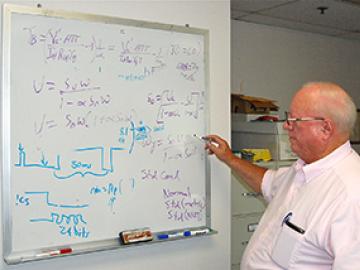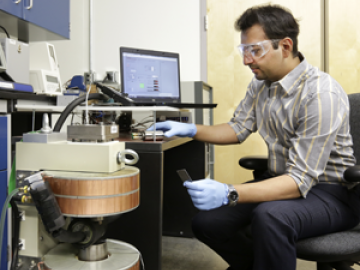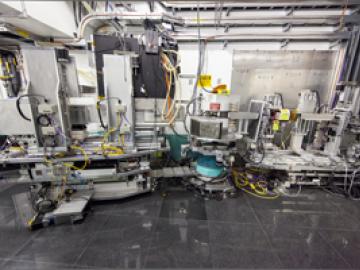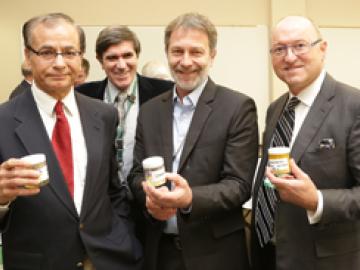Filter News
Area of Research
- (-) Clean Energy (522)
- (-) Computer Science (19)
- Advanced Manufacturing (34)
- Biological Systems (18)
- Biology and Environment (177)
- Biology and Soft Matter (5)
- Building Technologies (12)
- Chemical and Engineering Materials (4)
- Chemistry and Physics at Interfaces (11)
- Climate and Environmental Systems (14)
- Computational Biology (6)
- Computational Chemistry (5)
- Computational Engineering (5)
- Data (1)
- Earth Sciences (1)
- Electricity and Smart Grid (3)
- Energy Frontier Research Centers (14)
- Energy Sciences (5)
- Fossil Energy (3)
- Fuel Cycle Science and Technology (3)
- Functional Materials for Energy (16)
- Fusion and Fission (54)
- Fusion Energy (17)
- Geographic Information Science and Technology (3)
- Isotope Development and Production (3)
- Isotopes (35)
- Materials (433)
- Materials Characterization (2)
- Materials for Computing (36)
- Materials Synthesis from Atoms to Systems (13)
- Materials Under Extremes (12)
- Mathematics (1)
- National Security (79)
- Neutron Data Analysis and Visualization (4)
- Neutron Science (190)
- Nuclear Science and Technology (74)
- Nuclear Systems Modeling, Simulation and Validation (3)
- Nuclear Systems Technology (1)
- Quantum Condensed Matter (4)
- Quantum information Science (9)
- Reactor Technology (1)
- Renewable Energy (4)
- Sensors and Controls (5)
- Supercomputing (311)
- Transportation Systems (11)
News Type
News Topics
- 3-D Printing/Advanced Manufacturing (78)
- Advanced Reactors (6)
- Artificial Intelligence (14)
- Big Data (9)
- Bioenergy (26)
- Biology (11)
- Biomedical (6)
- Biotechnology (4)
- Buildings (36)
- Chemical Sciences (14)
- Clean Water (8)
- Climate Change (21)
- Composites (17)
- Computer Science (37)
- Coronavirus (12)
- Critical Materials (9)
- Cybersecurity (9)
- Decarbonization (33)
- Energy Storage (73)
- Environment (54)
- Exascale Computing (3)
- Fossil Energy (2)
- Frontier (2)
- Fusion (1)
- Grid (41)
- High-Performance Computing (8)
- Hydropower (2)
- Isotopes (1)
- Machine Learning (11)
- Materials (35)
- Materials Science (27)
- Mathematics (2)
- Mercury (3)
- Microelectronics (1)
- Microscopy (8)
- Molten Salt (1)
- Nanotechnology (8)
- National Security (5)
- Net Zero (3)
- Neutron Science (11)
- Nuclear Energy (7)
- Partnerships (12)
- Physics (1)
- Polymers (11)
- Quantum Science (5)
- Renewable Energy (1)
- Security (6)
- Simulation (4)
- Space Exploration (3)
- Statistics (1)
- Summit (5)
- Sustainable Energy (69)
- Transformational Challenge Reactor (3)
- Transportation (65)
Media Contacts

Researchers at the Department of Energy’s Oak Ridge National Laboratory got a surprise when they built a highly ordered lattice by layering thin films containing lanthanum, strontium, oxygen and iron. Although each layer had an intrinsically nonpolar (symmetric) distribution of electrical charges, the lattice had an asymmetric distribution of charges. The charge asymmetry creates an extra “switch” that brings new functionalities to materials when “flipped” by external stimuli such as electric fields or mechanical strain. This makes polar materials useful for devices such as sensors and actuators.

depth, population-based approach to identifying such mechanisms for adaptation, and describes a method that could be harnessed for developing more accurate predictive climate change models. For the U.S. Department of...

In the early 1980s, the Department of Energy’s Oak Ridge National Laboratory was just beginning to explore transfer of technology from the lab to industry. Now it's the norm, and one historical example illustrates the long-term benefits.

Not much has changed in refrigeration technology in the past 100 years, until now. Researchers with Oak Ridge National Laboratory’s Building Technologies Program have partnered with General Electric (GE) Appliances through a cooperative research and development agreement (CRADA) to revolutionize home refrigerators using magnetocaloric cooling.

KNOXVILLE— Philip Enquist, partner in charge of urban design and planning and leader of the City Design Practice at Skidmore, Owings and Merrill, has been named the 16th University of Tennessee-Oak Ridge National Laboratory Governor's Chair. Skidmore, Owings and Merrill is one of the world's leading...

Thomas Wilbanks and Benjamin Preston, both of the Climate Change Science Institute (CCSI) at Oak Ridge National Laboratory (ORNL), are among the 309 coordinating lead authors of the Intergovernmental Panel on Climate Change’s (IPCC’s) Working Group II (WG II) report.

Carbon dioxide in the atmosphere may get the lion’s share of attention in climate change discussions, but the biggest repository of carbon is actually underfoot: soils store an estimated 2.5 trillion tons of carbon in the form of organic matter.

Vertimass LLC, a California-based start-up company, has licensed an Oak Ridge National Laboratory technology that directly converts ethanol into a hydrocarbon blend-stock for use in transportation fuels.

Photovoltaic spray paint could coat the windows and walls of the future if scientists are successful in developing low-cost, flexible solar cells based on organic polymers. Scientists at the Department of Energy’s Oak Ridge National Laboratory recently discovered an unanticipated factor in the performance of polymer-based solar devices that gives new insight on how these materials form and function.

University of Tennessee (UT)-Oak Ridge National Laboratory Governor's Chair for Advanced Manufacturing Suresh Babu will lead the University of Tennessee's effort as part of a Detroit-based Lightweight and Modern Metals Manufacturing Innovation institute announced by President Obama on Feb. 25.




